If you’re looking for a fun and rewarding gardening project, why not try growing your own pumpkins? Not only will they make a great addition to your fall decor, but they’re also a versatile ingredient in all sorts of recipes. From savory soups and stews to sweet pies and bread, pumpkins are a staple of autumn. And the best part? They’re surprisingly easy to grow, even for beginners. So roll up your sleeves, get your hands dirty, and let’s start growing some pumpkins! Keep reading for your complete guide on how to grow pumpkins!
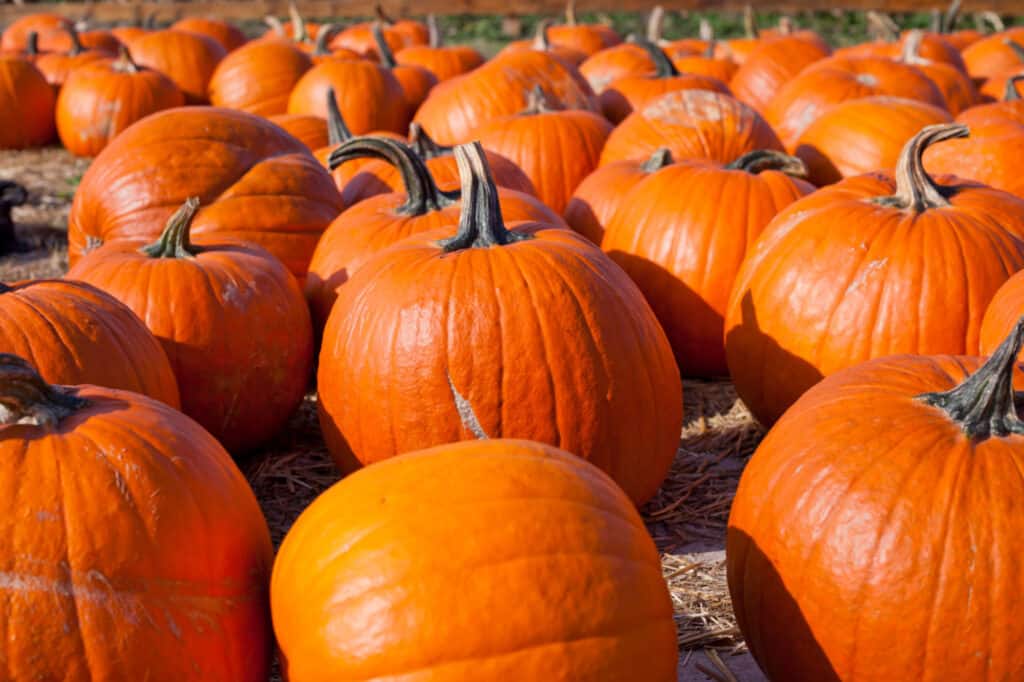
Pumpkins are easy to grow, even for beginners!
©JoannaTkaczuk/Shutterstock.com
What is a Pumpkin?
A pumpkin is a type of squash that belongs to the Cucurbitaceae family. The word pumpkin comes from the Greek word pepon, which means large melon. Pumpkins are large, round, or oblong fruit with a thick, hard skin that can range in color from yellow to orange to dark green. The inside of a pumpkin is filled with pulp and seeds. The pulp and seeds can be scooped out and used in a variety of culinary dishes. Pumpkins are native to North America, where they are harvested in the fall. They are often associated with autumn and Halloween and are used in many seasonal decorations and festivities. They are also a good source of vitamins and minerals, such as vitamin A, potassium, and fiber.

Pumpkins are often associated with autumn and Halloween and are used in many seasonal decorations and festivities.
©Romolo Tavani/Shutterstock.com
The distinction between pumpkins and squash can be a bit murky. There is no strict botanical definition to clearly separate the two. Pumpkins are actually a type of squash. In fact, all pumpkins are technically considered to be a variety of winter squash. However, pumpkins are commonly thought of as larger and rounder than most other types of squash.
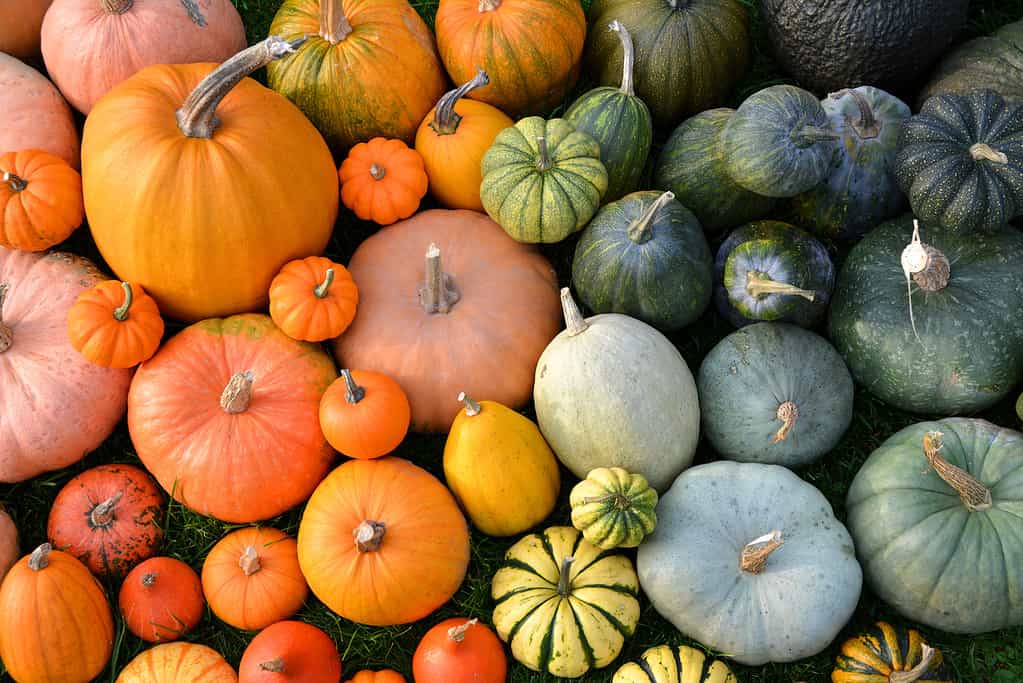
The distinction between pumpkins and squash can be a bit murky, as there is no strict botanical definition to clearly separate the two.
©Studio Barcelona/Shutterstock.com
How to Grow Pumpkins: Varieties
There are hundreds of different pumpkin cultivars within four main species of pumpkins: Cucurbita pepo, Cucurbita maxima, Cucurbita moschata, and Cucurbita argyrosperma.
- Cucurbita pepo includes many of the classic pumpkin varieties, such as Jack-o’-lantern pumpkins, as well as other types of squash like zucchini and acorn squash.
- Cucurbita maxima are the larger, sweeter pumpkins, such as the Hubbard squash, and some of the more unusual varieties, such as the Turban squash.
- Cucurbita moschata includes the popular butternut squash, as well as many other pumpkin and squash varieties.
- Cucurbita argyrosperma includes the Cushaw pumpkin, which is popular in the Southwestern United States.

is an excellent choice for baking.
©Manfred Ruckszio/Shutterstock.com
How to Grow Pumpkins: Requirements
Pumpkins are a warm-season crop and require a frost-free growing season to mature properly. Pumpkins require a lot of sunlight to grow, ideally 6-8 hours of direct sunlight per day. The perfect pumpkin patch receives full sun for most of the day. The optimal USDA Hardiness Zones for growing pumpkins are Zones 3-9, which cover most of the contiguous United States. You can discover your regional growing zone here.
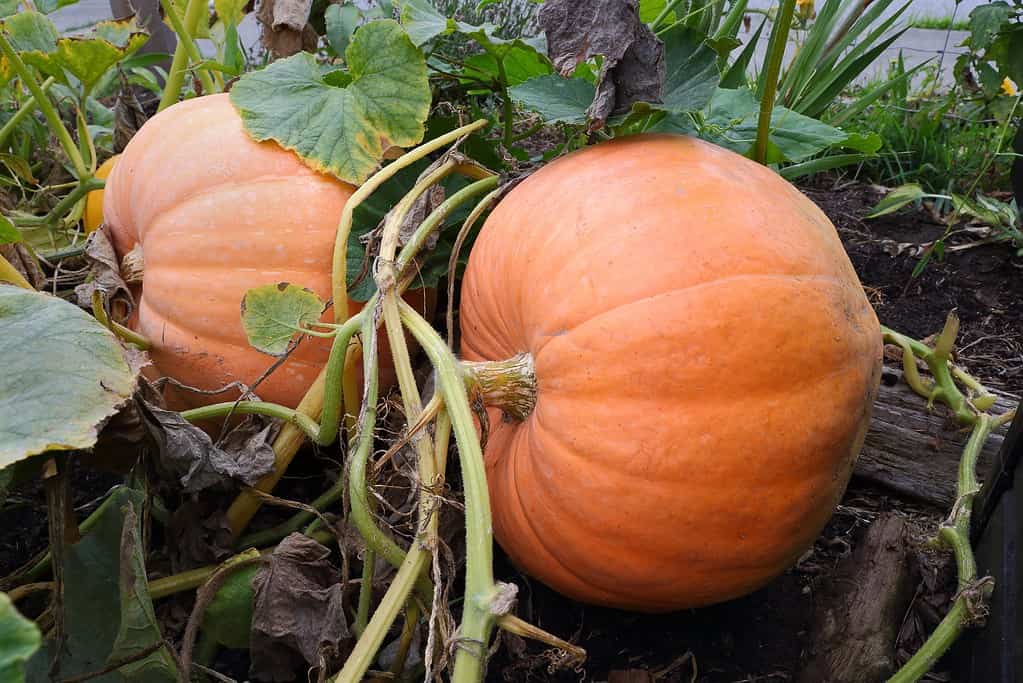
Pumpkins are a warm-season crop and require a frost-free growing season to mature properly.
©Max Lindenthaler/Shutterstock.com
Temperature Requirements
Pumpkins prefer warm temperatures and require soil that is at least 60°F (15.5 C) for optimal germination and growth. If you live in a cooler climate, you may need to start your pumpkin seeds indoors in the spring and transplant them outside after the last frost, or use protective measures such as row covers or frost cloth to extend the growing season. If you live in a hot and arid climate, you may need to provide some shade to protect the plants from excessive heat and sun exposure. It’s also important to provide adequate water to prevent the plants from wilting or becoming stressed in hot weather.
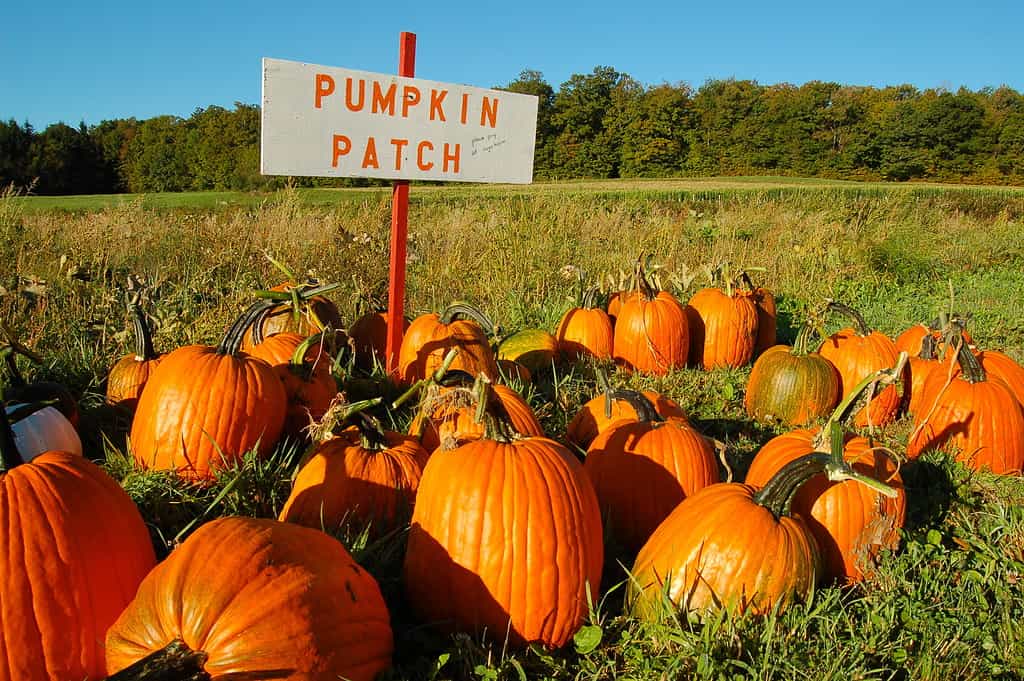
©Local Favorite Photography/Shutterstock.com
Soil Requirements
Pumpkins prefer a slightly acidic soil pH level of around 6.0 to 6.8. However, they can tolerate a wider pH range of 5.5 to 7.5. It’s important to test your soil before planting pumpkins and amend it as needed to achieve the optimal pH level. Soil testing kits/meters are available at garden centers or online and are easy to use. Learn more about soil pH levels here. If your soil is too alkaline, you can add elemental sulfur or acidifying fertilizers to lower the pH. If it’s too acidic, you can add lime to raise the pH. Maintaining the right soil pH level can help ensure that your pumpkins grow strong and healthy and produce a bountiful harvest.

Soil testing kits/meters are available at garden centers or online and are easy to use.
©Tama2u/Shutterstock.com
Space Requirements
You’ll need to devote a large amount of your garden space to your pumpkin crop, as pumpkins require space to grow properly. In general, a single pumpkin vine can grow to be quite large and can spread out over an area of up to 50 square feet (4.5 sq.m) or more. Growing pumpkins in a traditional garden bed, you should plan to give each plant at least 3-4 feet (1-1.5 m) of space in all directions to allow for the vine to spread out.
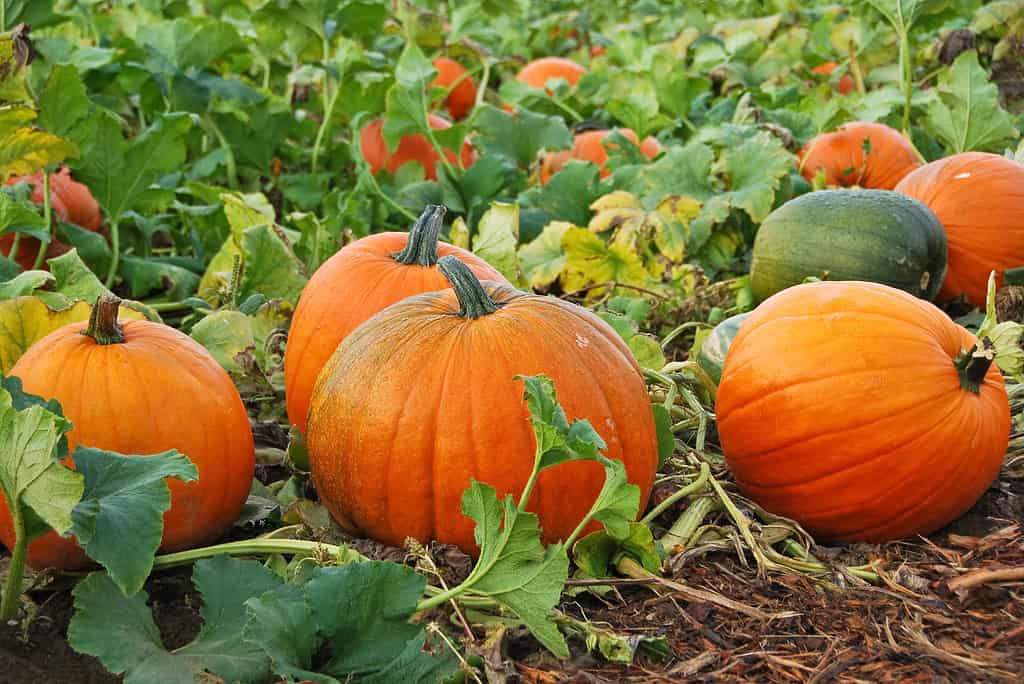
You’ll need to devote a large amount of your garden space to your pumpkin crop, as pumpkins require space to grow properly.
©Loren L. Masseth/Shutterstock.com
If you are growing multiple plants, you should space them at least 6-8 feet (2-2.5 m) apart to prevent the vines from overlapping and competing for resources. When growing pumpkins in a raised bed or container, you will need to make sure that the container is large enough to accommodate the vine. A container with a diameter of at least 3 feet (1 m) and a depth of 2-3 feet (0.75-1 m) should be sufficient for a single pumpkin plant.
Water Requirements
Pumpkins are thirsty little fellers that require consistent watering to grow and produce well. The soil around the pumpkin vine’s roots should be kept consistently moist throughout the growing season. In general, pumpkins require 1-2 inches (2.5-5 cm) of water per week, either from rain or supplemental watering. It’s important to water the pumpkin’s roots deeply and consistently. This helps to encourage deep root growth, which in turn allows the plant to access more nutrients and water from the soil.
If you live in a particularly hot or dry area, you may need to water your pumpkin plants more frequently to prevent them from becoming stressed or wilted. You can also help to retain moisture in the soil by adding a layer of mulch around the base of the plants.
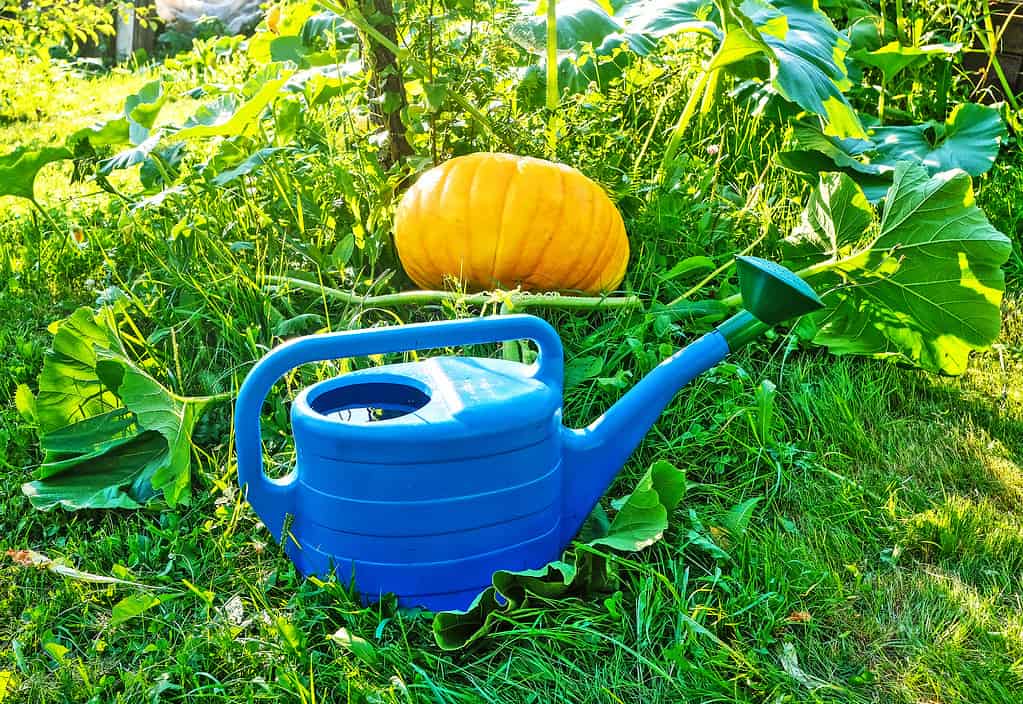
In general, pumpkins require 1-2 inches (2.5-5 cm) of water per week!
©ElenaG177/Shutterstock.com
How to Grow Pumpkins: Method
Though one can technically grow a pumpkin vine from a leaf or stem cutting, it is not a popular method for growing pumpkins. The most common method for growing pumpkins is starting from seed. That may look like direct sowing a pumpkin seed in the ground or starting seeds indoors that will be transplanted outdoors once the mercury rises. Small pumpkin plants (that were started from seed!) are readily available at your local gardening center, as well.
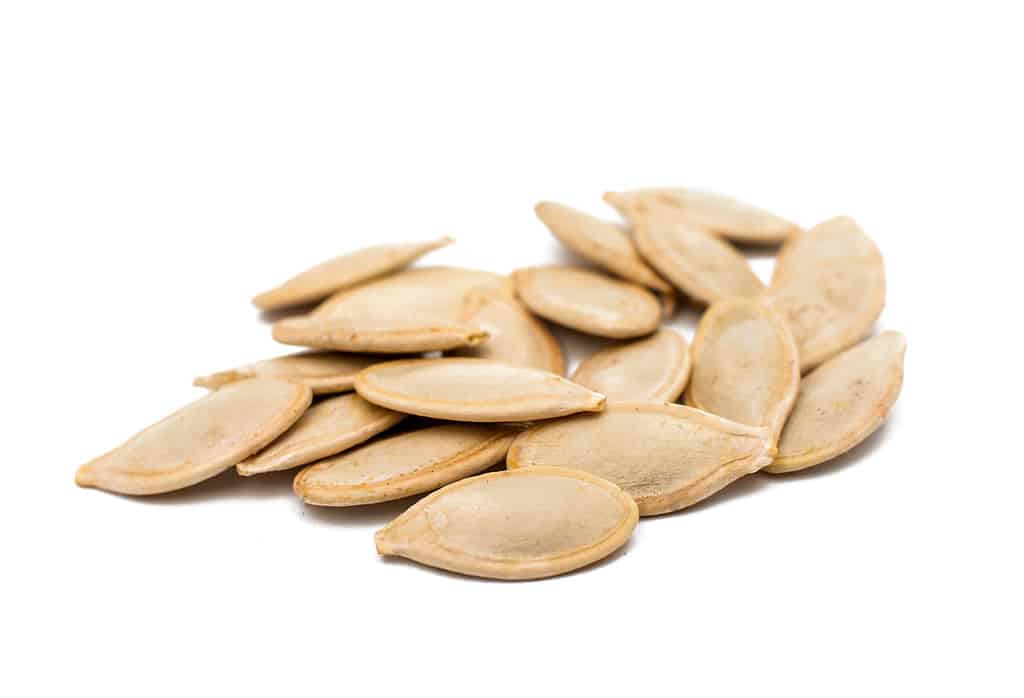
The most common method for growing pumpkins is starting from seed.
©oksana2010/Shutterstock.com
Direct Sowing
If you garden in a region that has a long growing season, the direct sowing method is for you! Direct seeding is the most common method of planting pumpkins and involves planting seeds directly into the garden soil. This method is relatively easy and requires minimal equipment, but it can be risky if the weather is not favorable. You’ll want to sow your seeds after the danger of frost has passed. Discover the last frost dates in your region here.
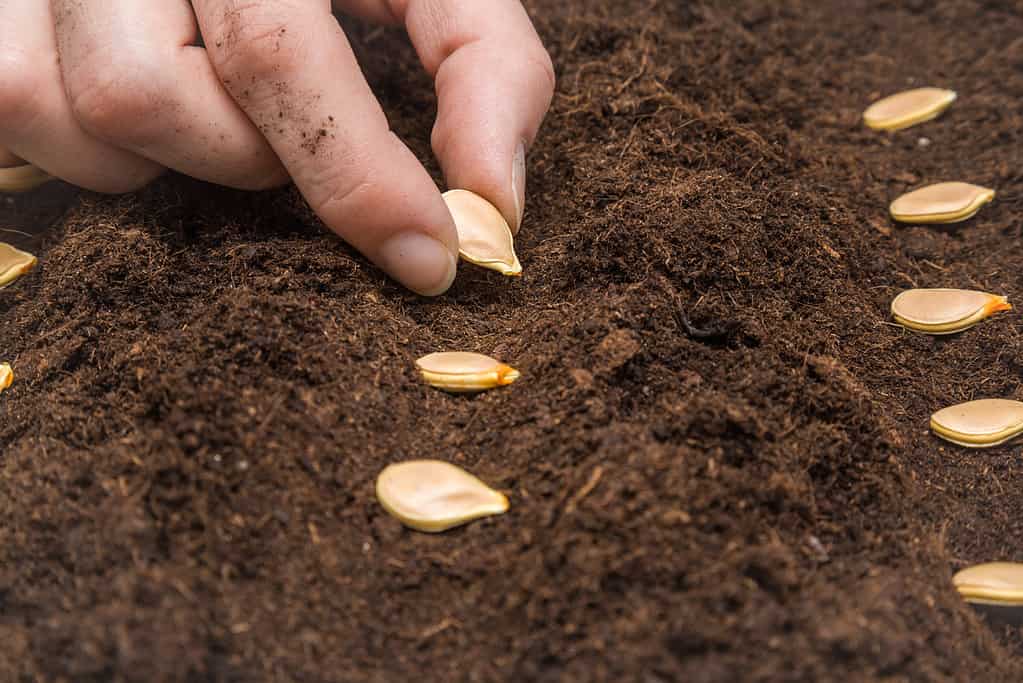
Whatever you do? Don’t plant your pumpkins this close together.
©FotoDuets/Shutterstock.com
Transplanting Seedlings
Another method for planting pumpkins is to start the seeds indoors and then transplant the seedlings into the garden once the weather has warmed up. This method allows for greater control over the growing conditions and can help to ensure a higher success rate, but it requires more equipment and time.
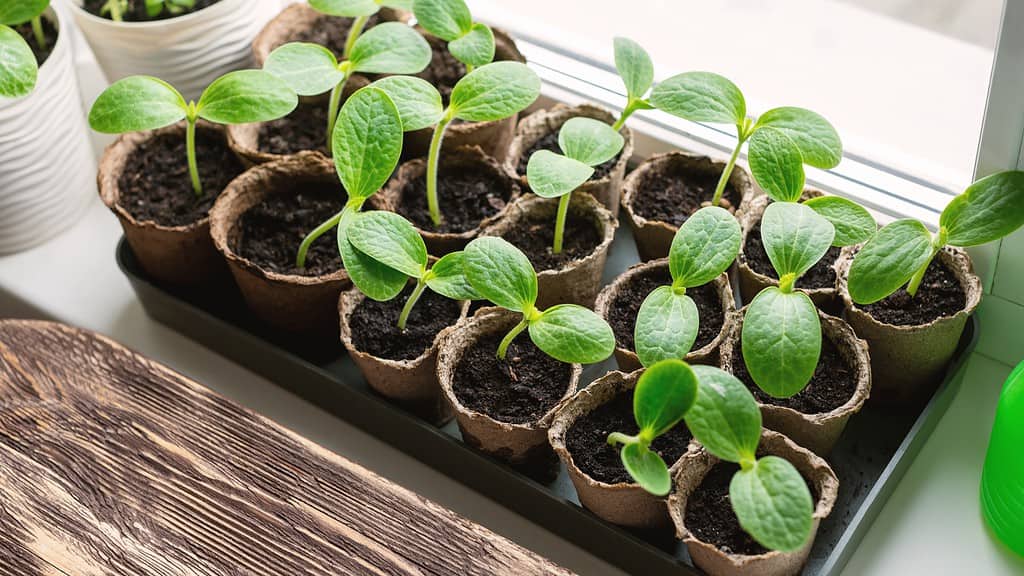
Starting pumpkins indoors allows for greater control over the growing conditions and can help to ensure a higher success rate.
©n.k.junky/Shutterstock.com
Pre-Started Bedding Plants
Pre-started plants are plants that have been started commercially that are ready to be planted directly into the garden. These are available at garden centers and nurseries. This method can be convenient for those who want to skip the seed-starting process, but it can be more expensive and may not offer as much variety as starting from seed.
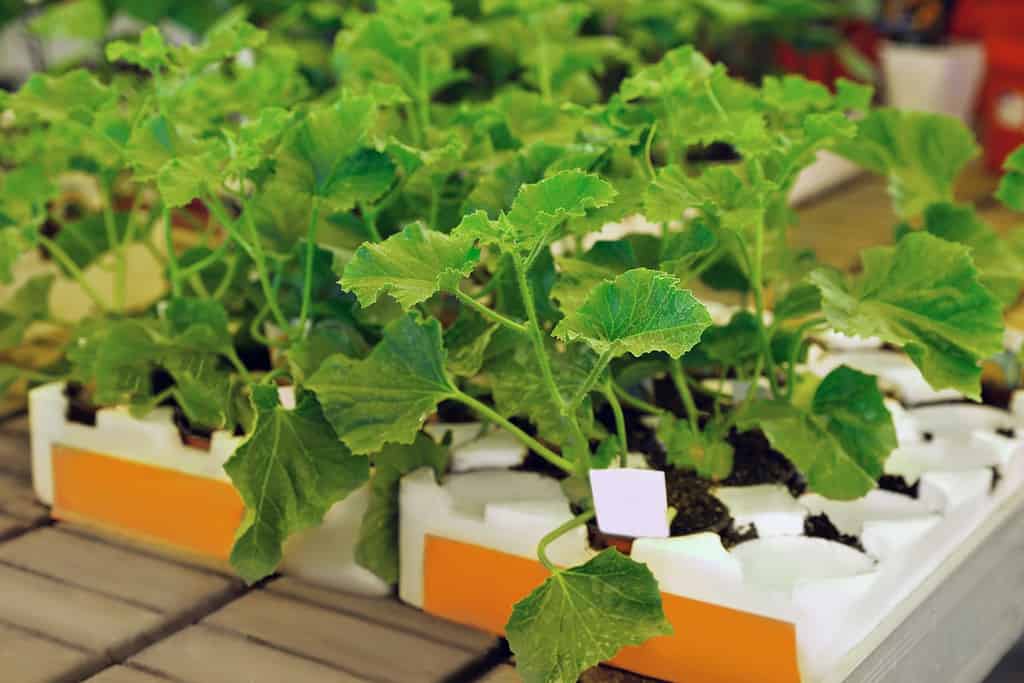
Pre-started plants are plants that have been commercially started that are ready to be planted directly into the garden.
©New Africa/Shutterstock.com
How to Grow Pumpkins: Step-by-Step
Follow these steps to a bountiful pumpkin harvest:
- Choose your pumpkin variety: First, choose the variety of pumpkin you want to grow and purchase the seed. There are many different types of pumpkins. Some common pumpkin varieties include Sugar Pie, Jack-o’-lantern, and Cinderella.
- Select a planting site: Choose a sunny location in your garden with well-draining soil. Pumpkins need a lot of sunlight to grow, so choose a spot that gets at least 6-8 hours of direct sunlight per day.
- Prepare the soil: Dig up the soil in your planting area to a depth of about 12 inches (30 cm) and add compost or other organic matter to improve drainage and fertility.
- Plant the seeds: If you are planting pumpkin seeds directly in the soil, space them about 2-3 feet (0.6 -1m) apart in rows or clusters. Make sure to plant the seeds about 1 inch (2.5 cm) deep in the soil with the pointed end facing down. If you are planting bedding plants, plant so that the container soil is even with the garden soil.
- Water and fertilize: Water your pumpkin seeds regularly, keeping the soil evenly moist. Once your seedlings have emerged, you can start fertilizing them with a balanced fertilizer that is high in phosphorus, which is important for root growth. As your pumpkin plants grow, make sure to keep them well-watered and weed-free.
Harvesting Your Pumpkins

Pumpkins must be cut from the vine with a knife.
©phBodrova/Shutterstock.com
Depending on the variety of pumpkin you are growing, it will take anywhere from 75 to 120 days for your pumpkins to mature. Look for signs that your pumpkins are ready to harvest, such as a hard rind and a dull, matte appearance, and dying foliage. Cut the pumpkins from the vine with a sharp knife, leaving a few inches of stem attached.
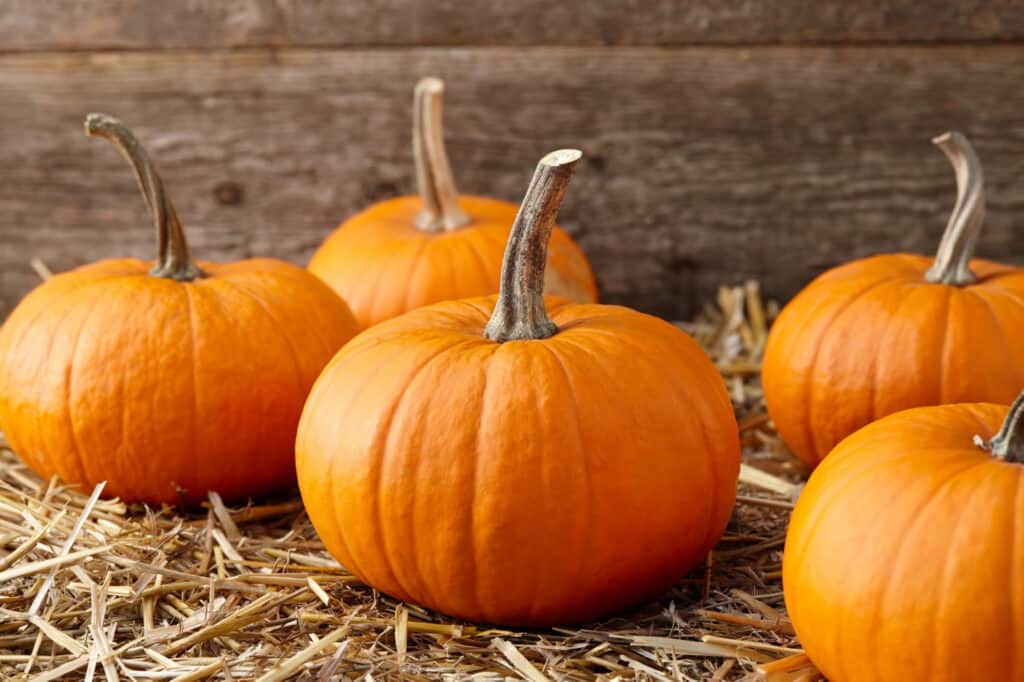
Depending on the variety of pumpkin you are growing, it will take anywhere from 75 to 120 days for your pumpkins to mature.
©kobeza/Shutterstock.com
Starting From Seed Indoors
If you are starting pumpkin seeds indoors, the process is very similar. This method involves planting pumpkin seeds in containers filled with sterile, well-draining potting mix, and providing them with warmth, light, and moisture. Once the seeds germinate and the seedlings grow a few sets of leaves, thin them down to one seedling per container, choosing the strongest and healthiest-looking plant. Before transplanting the seedlings outdoors, it’s important that they harden off gradually by exposing them to outdoor conditions for longer and longer periods over the course of a few weeks. This allows the seedlings to adjust to the changes in temperature, wind, and sunlight, which can help them to grow stronger and more resilient. Once the seedlings are ready to be transplanted, return to step three above and proceed from there.
Container Planting
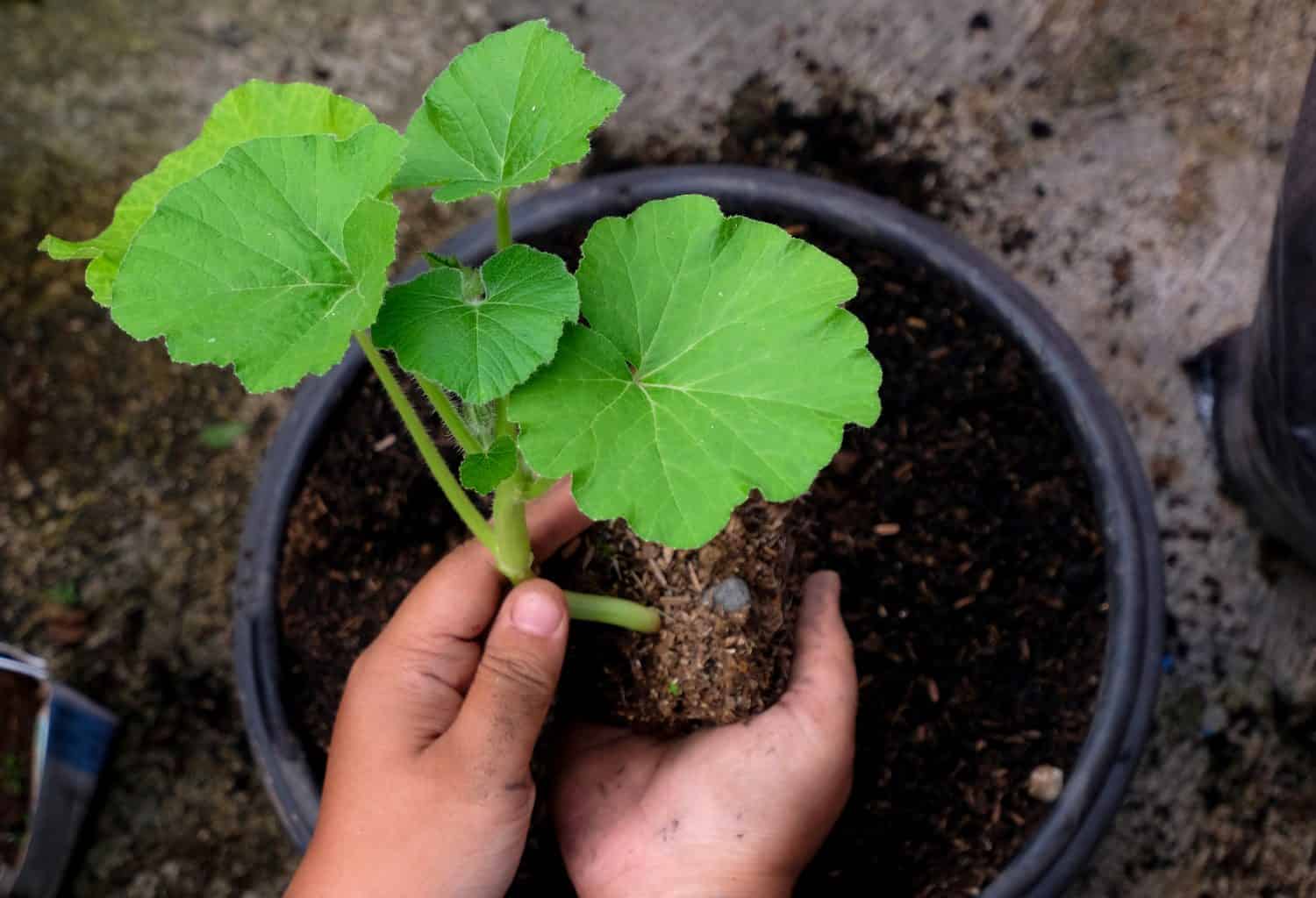
Smaller varieties of pumpkin can be grown in pots.
Image: Hasiah Z, Shutterstock
©Hasiah Z/Shutterstock.com
Pumpkins can be grown in containers, but it’s important to choose the right container and provide the right growing conditions. Growing a smaller variety of pumpkin or limiting fruit set can be a good option for those who want to grow pumpkins in a smaller space or in containers.
Here are some tips for growing pumpkins in containers:
- Choose a compact or bush-type pumpkin variety: Look for pumpkin varieties that are naturally more compact and don’t spread out as much as traditional pumpkin vines. Examples of compact pumpkin varieties include Baby Bear, Hooligan, and Jack Be Little.
- Choose a large container: Pumpkins have deep root systems that require a lot of room to grow. Choose a container that is at least 5 gallons (20 L) in size, and larger if possible. The container should also be at least 2-3 feet (0.5-1 m) deep and wide. This will provide enough room for the pumpkin’s roots to grow and allow the plant to support the weight of the fruit. Make sure the container has drainage holes.
- Use the right soil: Use a high-quality potting mix that is well-draining and rich in nutrients. Avoid using garden soil or heavy clay soils, which can become compacted and hinder root growth.
- Provide enough water: Container-grown pumpkins require more frequent watering than those grown in the ground. Keep the soil consistently moist. Water deeply to encourage deep root growth.
Caring for Your Container Pumpkin:
- Provide support: Pumpkins can get heavy and require support to prevent the vines from breaking. Use a trellis, stake, or other support structure to keep the vines upright.
- Provide enough sunlight: Pumpkins require at least 6-8 hours of direct sunlight per day. Choose a location that receives full sun for most of the day.
- Fertilize regularly: Pumpkins are heavy feeders and require regular fertilization to produce a bountiful harvest. Use a balanced fertilizer or compost every few weeks throughout the growing season.
Pumpkins grow and mature rather quickly, and your container pumpkins can be ready in 4-5 months.
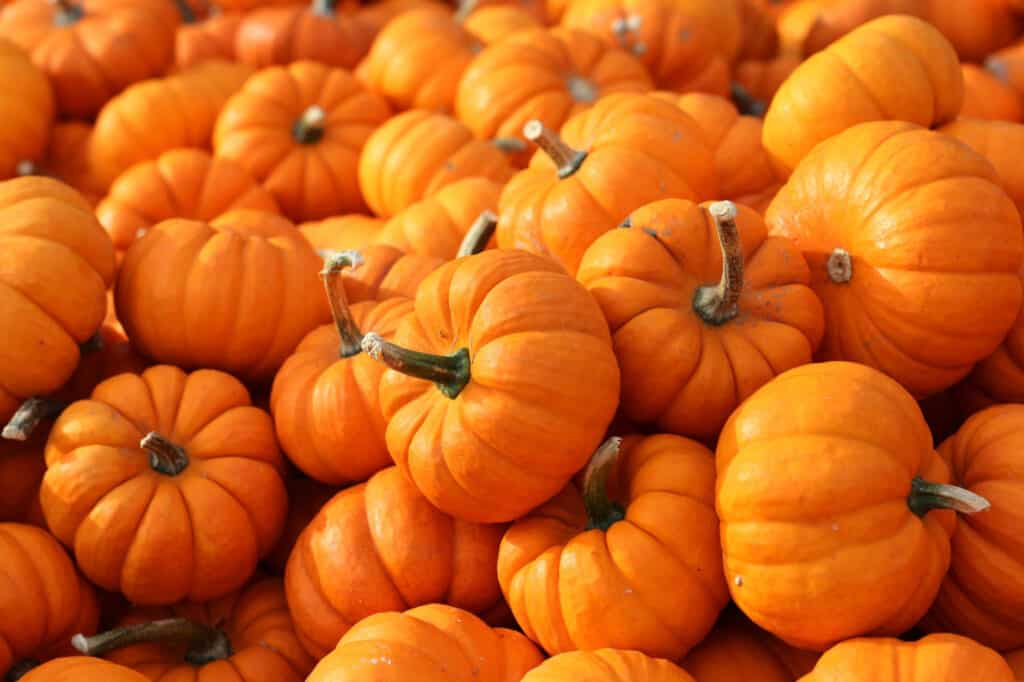
Growing a smaller variety of pumpkin or limiting fruit set can be a good option for those who want to grow pumpkins in a smaller space or in containers.
©AN NGUYEN/Shutterstock.com
Five Fun Facts about Pumpkins
- The town of Morton, Illinois bills itself as the Pumpkin Capital of the World and hosts an annual pumpkin festival.
- The largest pumpkin ever grown weighed over 2,600 pounds (1 metric ton) and was grown in Belgium in 2016.
- The tradition of carving pumpkins for Halloween comes from an old Irish legend about a man named Stingy Jack who tricked the devil and was condemned to wander the earth with only a carved-out turnip to light his way.
- Though most of us think of pumpkins as being orange, pumpkins come in a variety of shades of yellow, green, and white, besides orange.
- Pumpkins are a good source of fiber, vitamins A and C, and potassium.
The photo featured at the top of this post is © Max Lindenthaler/Shutterstock.com
Thank you for reading! Have some feedback for us? Contact the AZ Animals editorial team.






